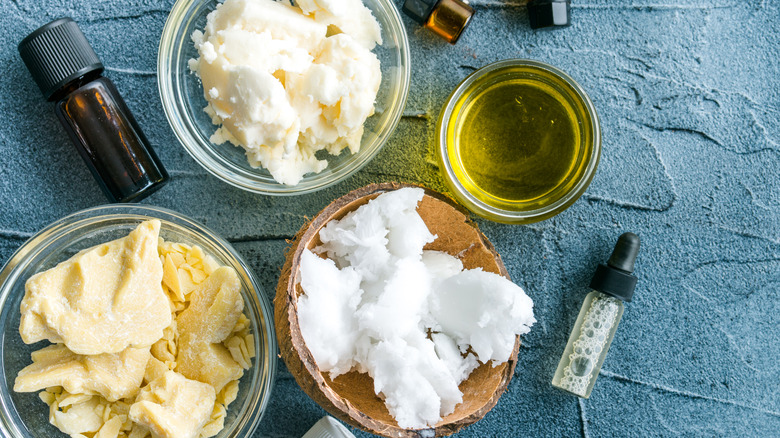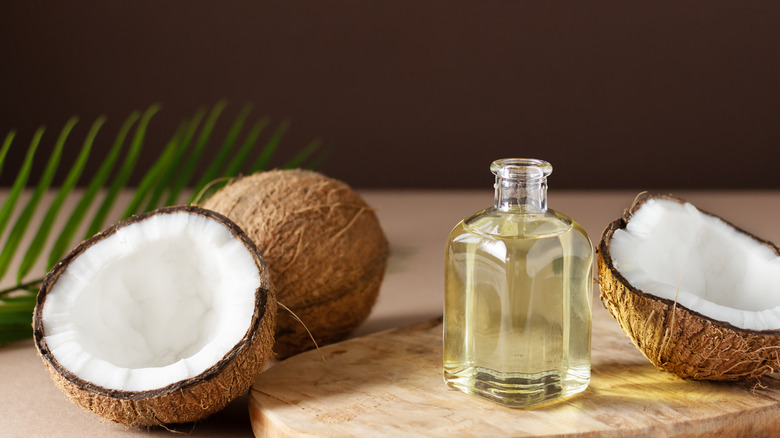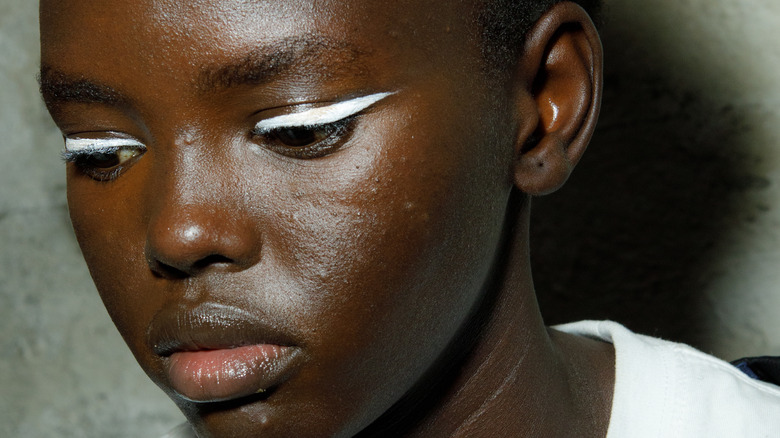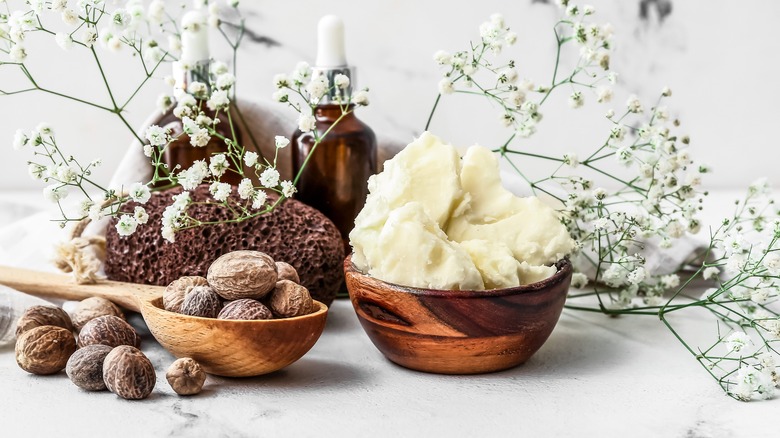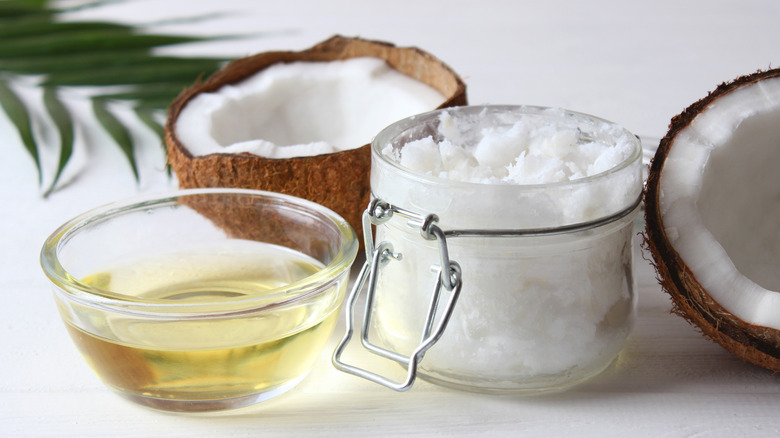Shea Butter And Coconut Oil Are Ultra-Moisturizing, But They Can Also Have Sneaky Side Effects
We may receive a commission on purchases made from links.
Moisturizing your skin and hair is vital in every face and body care routine. From keeping your skin's moisture barrier protected and healthy to preventing hair breakage due to harsh weather conditions, it's a part of your self-care routine that you should make a consistent ritual with whatever options you prefer. While some prefer body lotions and scalp hydrating serums (which are lightly moisturizing and do not sit heavy on the skin), others prefer body butters and hair creams — which moisturize much deeper. These body butters and hair creams usually feature two rockstar ingredients: shea butter and coconut oil.
Native to certain parts of Africa, like Nigeria and Ghana, shea butter is derived from the seeds of the Shea tree (per American Shea Butter Institute). Shea butter, made from the rigorous process of drying the seeds and extracting the oils, is a critical ingredient in some of our favorite moisturizers and hair products. It's the same for coconut oil, which, as Virginutty explains, is derived from the white fleshy part of coconuts. Both of these ingredients are extensively used in our cosmetics for their fantastic benefits. But as great as they seem, they can become problematic for your skin. Here's why they are both prized ingredients in our cosmetics — and what you should look out for.
Skin and hair benefits of shea butter and coconut oil
It is common to find coconut oil and shea butter in most moisturizing and smoothing products, primarily due to the fatty acids and vitamins in their chemical composition. According to Better Shea Butter, shea butter is rich in vitamins A and E and contains fatty acids like oleic acid, palmitic acid, and stearic acid. With these nutrients, shea butter acts as an emollient, keeping your skin smooth and moisturized for longer. In addition to its moisturizing properties, shea butter (with its many antioxidants), is anti-inflammatory and helps to soothe skin conditions like eczema, dermatitis, and psoriasis (per Aveeno). Also, shea butter has an SPF range of 6 to 10, which helps protect you from the sun. But of course, it is no replacement for sunscreen.
It's the same for coconut oil, which beauty expert and plastic surgeon Dr. Monica Tadros explains is also rich in fatty acids and antioxidants (per Dermstore). These fatty acids and antioxidants keep your barrier healthy and retain moisture in your hair. In addition, coconut also contains lauric acid and capric acid, two acids Nivea confirms are antimicrobial and thus keep the skin and hair's microbiome free from harmful bacteria.
Overall, shea butter and coconut oil are nature's gifts to our beauty routines, and their benefits explain why they're commonly used in our beauty products. But with their many benefits comes a potential side effect: their pore-clogging properties.
Comedogenicity and the comedogenic scale
According to Skin Library, coconut oil has a comedogenic rating of 4, which places it pretty high on the pore-clogging scale. Shea butter, on the other hand, has a rating of 0 to 2, making it less comedogenic than coconut oil but still with the tendency to clog pores. Don't know what comedogenicity means? Here's a quick class on that.
When you apply certain skincare products, there is a chance that they can block or clog your pores, forming comedones. Comedones are tiny bumps or papules on the skin's surface and can be whiteheads or blackheads. This tendency of a skincare ingredient to clog your pores and form said comedones is the ingredient's comedogenicity (per Acne.org). Just as different skincare ingredients have different chemical formulas and formulations, they also have different comedogenic ratings. These ratings are measured on a scale of 0 to 5, which tells us how easily they clog your pores. A rating of 0 means the ingredient will not clog your pores at all, 1 indicates low comedogenicity, 2 to 3 denotes moderate comedogenicity, and 4 to 5 is the highest with likely clogging of your pores. And when your pores are clogged, it can cause specific skin concerns like acne, rough texture, and dull-looking skin (per Healthline).
Now that you know what comedogenicity is, here's how applying your shea butter and coconut oil directly to your skin might make them the major pore-clogging culprits.
What does this rating tell about shea butter and coconut oil?
Even though coconut oil has several excellent skin benefits, its comedone-forming nature is something to be wary of when applying it directly to your skin. With its high comedogenicity, using coconut oil straight to your face can cause breakouts and folliculitis to arise. And yes, you might wonder: "But doesn't coconut oil contain microbe-destroying lauric acid? Shouldn't that be enough to offset its comedogenicity or get rid of the acne?" Although YORA Skin Science confirms that coconut oil is antimicrobial, they also state that it can still clog your pores. So to prevent further skin irritation, people with acne-prone and oily skin should skip using coconut oil directly on their skin.
With a rating of 0 to 2, shea butter is much lower than coconut oil on the comedogenic scale, making it less likely to clog your pores. However, Naturally Tribal Skincare explains that while there's barely enough research to confirm that it is not comedogenic, the consistency of shea butter suggests the likelihood that it just might be. And currently, the American Academy of Dermatology does agree that shea butter can clog the pores on your face, back, and chest.
Should I be worried about shea butter and coconut oil in my skincare products?
Now, the comedogenic scale, with its 0 to 5 rating, is useful in helping us understand our skincare ingredients and how they act on the skin. However, you do not need to follow it to a T. Blissoma explains that just because a skin care ingredient has a high comedogenic rating does not mean a product containing it is also highly comedogenic. Also, the basis for many comedogenicity tests needs to be revised and requires more research.
What this means is if your favorite moisturizer has some shea butter or coconut oil in it, it is not a sign that you should not use the product. Instead, follow Lab Muffin's advice and treat comedogenic ratings as a guide instead. Use them to pinpoint what ingredient in a product could be causing you to break out — whether it's oils like coconut oil and soybean oil or butters like cocoa butter. Or even better, use less polarizing skincare ingredients like hyaluronic acid, ceramides, peptides, and polyglutamic acid for your face, which is more prone to clogging and breakouts.
Overall, shea butter and coconut oil are undeniably excellent moisturizers and occlusives rich in antioxidants, vitamins, and fatty acids. Still, you can not ignore that they tend to cause even more problems to your skin. Therefore, be wary of using these ingredients on your skin, especially if you have sensitive skin or are blemish-prone.
